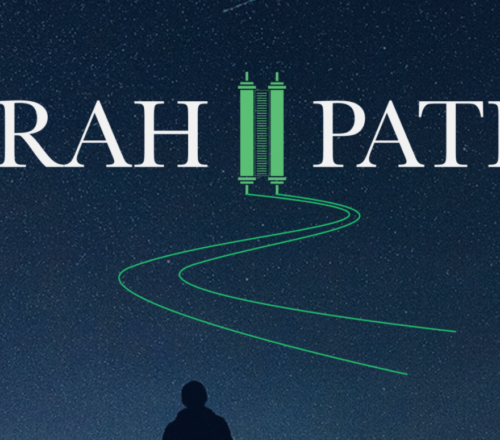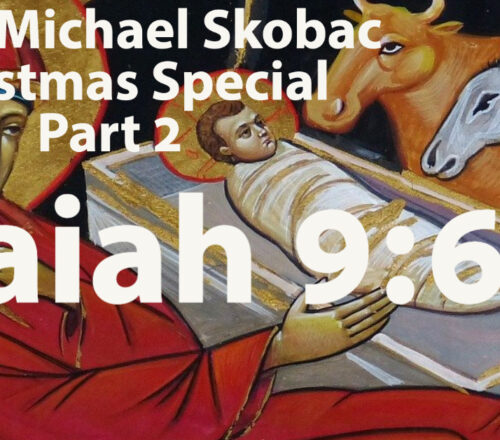365 Messianic Prophecies – Episode #28 – Daniel 9 – Part 2 – Rabbi Michael Skobac
In the first year of Darius the son of Ahasuerus, of the lineage of the Medes, who was made king over the realm of the Chaldeans; in the first year of his reign I, Daniel, understood by the books the number of the years specified by the word of the Lord through Jeremiah the prophet, that He would accomplish seventy years in the desolations of Jerusalem. – Daniel 9:1-2
Join us as we continue to investigate the alleged 365 messianic prophesies in the Tanakh that Jesus supposedly fulfilled in the New Testament!
Join us for this year’s Tanakh Tour of Israel!
[sc_embed_player fileurl=”https://truth2u.org/wp-content/uploads/Audio/Truth2U%20-%20Michael%20Skobac%20-%20365%20Messianic%20Prophecies%20-%20Daniel%209%20-%20Pt%202.mp3″ autoplay=”true” loops=”true”]
[wp-post-slider]






Thank you for the exciting lesson. My question is with regards to the septets. The seven septets (49 years) run from when to when? And the 62 septets (434 years) runs from when to when?
Thank you for the wonderful learning opportunity these broadcasts offer.
JP
Daniel 9 gives us a time line in the first verse.
Daniel 9:2 “In the first year of his (Darius) reign, I, Daniel, contemplated the calculations, the number of years about which the word of HaShem had come to the prophet Jeremiah, to complete the seventy years since the ruin of Jerusalem. 2. I set my face toward the L-rd, G-d, to beseech (with) prayer and supplication, with fasting, sackcloth and ashes.”
Darius the Mede (Jewish year 3389) who just conquered the Babylonian. Why is Daniel bothered by something that the angel had to come and explain to him?
Daniel was trying to figure out the number of years that the devastation of Jerusalem had to have happened per the prophecy of Jeremiah. Read Jeremiah 25 and 29.
In chapter 25 Jeremiah said “and this whole land shall be in desolation” (for 70 years) “when 70 years are accomplished I shall punish the King of Babylon. . .and make it perpetual desolation.”
Then in chapter 29 Jeremiah said: “For thus said HaShem: After seventy years are accomplished for Babylon, I will remember you, and perform My good word toward you, in causing you to return to this place.”
Daniel is thinking “the Babylonians have been destroyed” (year 3389, 70 years after the conquest of Judah).” Daniel assumed the 70 years began with the subjugation of the Jews and that Jeremiah’s prophecy of 70 years is “up.”
The second prophecy of Jeremiah says the Jews will go back to Judah (Israel).
The main topic of Daniel 9 is his pain at the destruction of the Temple. What Daniel is bothered by is that one part of the prophecy came true (the Babylonians have been deposed) but the second part, the rebuilding of the Temple, has not happened. It is one year from where he sat (3389). But there were no Jews in Israel one year before the 70th year — so how could Jeremiah’s prophecy that the Temple would be rebuilt by 3390 when there were no Jews in Israel (Judah)?
Daniel was confused because he thought Jeremiah had made one prophecy and that they both had the same starting date. Daniel was nervous that the Temple was not going to be rebuilt and that G-d was going to cancel the promise to rebuild the Temple.
Daniel then prays to G-d to rebuild Jerusalem and the Temple, even though the people have sinned.
O L-rd, hear; O L-rd, forgive; O L-rd, hearken and do, do not delay; for Your sake, my G-d, for Your Name is called upon Your city and upon Your people.” Daniel 9:19.
Then the angel Gavriel comes and tells Daniel. This is when 9:25 tells us that the 70 weeks (of years) of the Babylonian exile — it was a time the Jews had time to repent and be forgiven. Gavriel tells Daniel that the first prophecy was 70 years of subjugation of Israel, but the return to Israel begins from the destruction of the Temple (which was 18 years after the Jews were sent into exile). The year 3338 was when the destruction of the Temple happened. 3408 is when the Temple was complete and built — 70 years as prophecied.
So it is from the destruction of Jerusalem, not from the exile — so Daniel’s concern about the Temple being rebuilt was off by 18 years.
Daniel 9:25 says “you shall know and comprehend from the word to rebuild Jerusalem” (the word is d’var, translated as “word”, not “command” as many Chrstians including the KJV translate it. The word for “command” in Hebrew is mitzvah, not d’var).
There is a second reason the starting point cannot be Artaxerxes as the Chrstians like to state. Daniel is sitting in the year 3389 / 90. The angel Gavriel is going to “make Daniel wise” how could Daniel know that sometime in the future there is going to be a decree to rebuild Jerusalem — Daniel would not be any wiser. He would know nothing more than he did before the angel told him anything.
If the starting point for the count down is some indefinite time after Daniel is sitting with the angel the message is meaningless to him. Clearly the starting point must be some time before 3389 so Daniel can count “7 weeks of years” and then he will know what the angel is saying.
And he enabled me to understand, and he spoke with me, and he said, “Daniel, now I have come forth to make you skillful in understanding. Daniel 9:22
Daniel needs to start counting the 49 years at some point. Is it the year 444 of the common era which is long past his death?? How does that make any sense at all? How does that make Daniel “skillful in understanding”?
From the Chrstian understanding if they starting counting from 444 BCE Daniel knows nothing more than he did before the angel spoke to him, putting lie to what the angel told Daniel (that he would be able to understand!).
The angel says there is a d’var (a word) concerning the rebuilding of Jerusalem. That is the word of Jeremiah. Daniel is being told that 7 weeks from the destruction of Jerusalem (49 years) an anointed prince will come.
Daniel wants to know WHEN WILL THE TEMPLE BE REBUILT? If Artaxerxes were the starting point Daniel would have been long dead and would not have understood anything.
The Artscroll footnotes are useful:
9:24 Lit., “seventy weeks,” this phrase refers to seventy times seven years – or 490 years. This refers to the seventy years of exile that have passed sine the Destruction of the First Temple (Sophiee’s note: see 9:2-3 quoted above) until this vision and the entire 420 year period of the Second Temple (Rashi).
9:25 The “septets” refer to full seven-year periods. The prince of this verse is Cyrus, who gave permission to rebuild Jerusalem and the Temple. He ascended to the throne fifty-two years (seven full septets plus three years) after the exile has begun. From then until the second destruction of Jerusalem was 438 years, or sixty two septets and four years (Rashi).
9:26 I.e., Agrippa, the last Jewish king, at the end of the second Temple era. After his death, the prince of this verse – the Roman Titus, would command the destruction of the Temple, which will not rebuilt until after the War of Gog and Magog in messianic times (Rashi).
9:27 The Roman emperor would make a treaty with the Jewish nation for seven years, but for the second half of the term the Romans would violate that covenant and impede the Temple service. The “mute abomination,” i.e. a temple idolatry, was erected by the emperor Hadrian on the Temple Mount (Rashi).
There is a difference between the Jewish calendar and the secular calendar to consider, too. You might want to read Rabbi Moshe Shulman’s article “Daniel 9: It’s Chronology and Meaning.” http://judaismsanswer.com/Daniel%209%20Chronology.pdf
Thank you Sophiee for the detailed answer. I got it.
Another question: where do we get the idea to add 3 years to the “7 septets” and 4 years to the “62 septets”? Where do we see that in the text of Daniel?
Thanks again!
A shavuim (“septet” in the Artscroll) is a 7 year period counted as a single “shavuim.” Cyrus ascended his throne after 7 septets (and before the 8th). The same is true from then until the destruction of the second Temple — it happened 62 shavuim (“septets”) later — and before the 63rd Shavuim. The years prior to the next shavuim simply get “counted” with the previous shavuim.
I highly recommend that you read the article I linked to by Rabbi Moshe Shulman. He covers:
1. Discusses the Secular chronology and how modern Christians interpret Daniel 9 using it.
2. Discusses the Biblical/Rabbinic chronology and how the Rabbis interpret Daniel 9.
3. Discusses the Christian interpretation of Daniel 9 and compares it to the Biblical chronology.
4. Discusses the problems with the secular chronology and how to understand the Biblical
chronology and Rabbinic interpretation of Daniel 9 if we take the secular chronology as the
correct one.
5. Discusses problems with the modern Christian interpretations.
He also added a number of Appendices with important extra information. These are:
1. Rashi’s alternative view of the chronology of Persia.
2. Ibn Ezra’s view of the chronology of Persia.
3. Josephus and Daniel 9.
4. Early Church Fathers and Daniel 9
The whole “numbers” thing can be confusing — hopefully that will help.
490 years were given for the Jews to purify themselves. Not until then, the messianic age would have come. Apparently the messianic age did not come immediately after the 490 years ended. Does this mean that they did not succeed to do what they were supposed to do in that 490 year period?
huferry, Daniel 9 is not about the messianic age. It is not a messianic prophecy.
Daniel is bookending the return from the exile in Babylon with the second exile of the Jews by the Romans. The first messiah is Cyrus, the king who gave the order to rebuild Jerusalem. From the time the order is given the Jews have nearly 500 years to return to observance and avoid a second exile. If they do, then they will avoid a second exile. (All negative prophecies are warnings that can be averted if one listens to the warning).
The Jews did not heed the warning — indeed the Second Temple period was one of great strife. The Jews actually invited the Romans in! Some Jews became very Hellenized (Romanized). There were many splinter groups, one of whom actually torched to food within the walls of Jerusalem — destroying their fellow Jews. States the Talmud (Yoma 9b): “Why was the Second Temple destroyed? Because of sinat chinam, senseless hatred of one Jew for another.”
Hence the second exile was not avoided. The Temple was destroyed in 68 CE and around 135 CE the Jews were exiled from Judah — most of us for 2000 years.
The term “messiah” is used 39 times in the T’nach. It means “anointed one” and it refers to kings and priests. In the case of Cyrus it refers to a non-Jewish king. The evil messiah who is cut off from G-d at the end of the 490 years could have been Agrippa, or even Titus (who became the anointed emperor of Rome).
The fact that there is no definite article (messiah but not “the” messiah) indicates that this second anointed one (messiah) could refer to several different anointed subjects. King Herod Agrippa the last King of Judah (Kings are considered anointed as it says in 1 Chronicles 11:3). He was killed during this time (around 44 CE). Messiah could also refer to the last High priest (priests are anointed as seen in Vayikra / Leviticus 4). There was also Titus (Emperor) who made a treaty with the Jewish nation for seven years, but for the second half of the term the Romans would violate that covenant and impede the Temple service. He eventually became the Roman emperor and died around 81 CE.
My point being Daniel 9 has nothing to do with “the” messiah or the messianic age. David was a messiah. Aaron was a messiah. Saul was a messiah. Cyrus was a messiah. Solomon was a messiah. . . none of them were “the” messiah and the messiahs (plural) in Daniel 9 weren’t the messiah either.